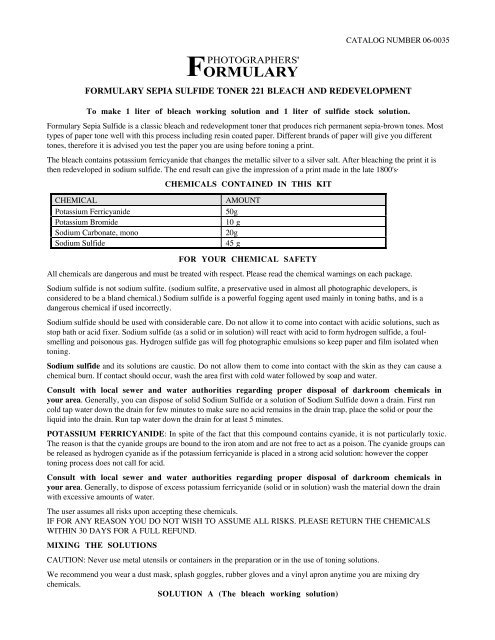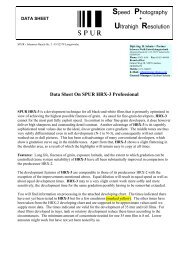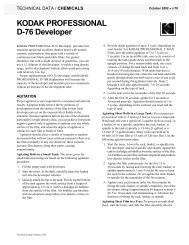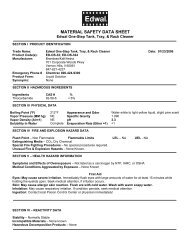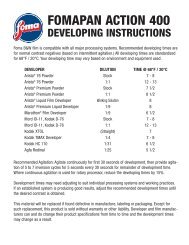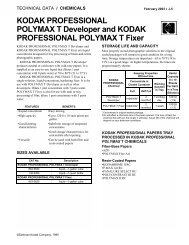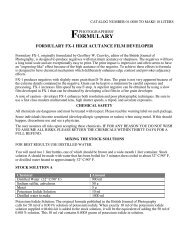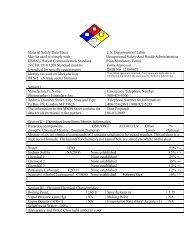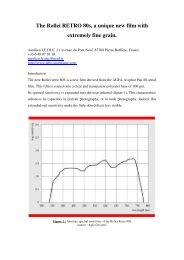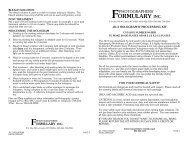Instructions & Technical Data (pdf)
Instructions & Technical Data (pdf)
Instructions & Technical Data (pdf)
Create successful ePaper yourself
Turn your PDF publications into a flip-book with our unique Google optimized e-Paper software.
CATALOG NUMBER 06-0035<br />
PHOTOGRAPHERS'<br />
FORMULARY<br />
FORMULARY SEPIA SULFIDE TONER 221 BLEACH AND REDEVELOPMENT<br />
To make 1 liter of bleach working solution and 1 liter of sulfide stock solution.<br />
Formulary Sepia Sulfide is a classic bleach and redevelopment toner that produces rich permanent sepia-brown tones. Most<br />
types of paper tone well with this process including resin coated paper. Different brands of paper will give you different<br />
tones, therefore it is advised you test the paper you are using before toning a print.<br />
The bleach contains potassium ferricyanide that changes the metallic silver to a silver salt. After bleaching the print it is<br />
then redeveloped in sodium sulfide. The end result can give the impression of a print made in the late 1800's·<br />
CHEMICALS CONTAINED IN THIS KIT<br />
CHEMICAL<br />
Potassium Ferricyanide<br />
Potassium Bromide<br />
Sodium Carbonate, mono<br />
Sodium Sulfide<br />
AMOUNT<br />
50g<br />
10 g<br />
20g<br />
45 g<br />
FOR YOUR CHEMICAL SAFETY<br />
All chemicals are dangerous and must be treated with respect. Please read the chemical warnings on each package.<br />
Sodium sulfide is not sodium sulfite. (sodium sulfite, a preservative used in almost all photographic developers, is<br />
considered to be a bland chemical.) Sodium sulfide is a powerful fogging agent used mainly in toning baths, and is a<br />
dangerous chemical if used incorrectly.<br />
Sodium sulfide should be used with considerable care. Do not allow it to come into contact with acidic solutions, such as<br />
stop bath or acid fixer. Sodium sulfide (as a solid or in solution) will react with acid to form hydrogen sulfide, a foulsmelling<br />
and poisonous gas. Hydrogen sulfide gas will fog photographic emulsions so keep paper and film isolated when<br />
toning.<br />
Sodium sulfide and its solutions are caustic. Do not allow them to come into contact with the skin as they can cause a<br />
chemical burn. If contact should occur, wash the area first with cold water followed by soap and water.<br />
Consult with local sewer and water authorities regarding proper disposal of darkroom chemicals in<br />
your area. Generally, you can dispose of solid Sodium Sulfide or a solution of Sodium Sulfide down a drain. First run<br />
cold tap water down the drain for few minutes to make sure no acid remains in the drain trap, place the solid or pour the<br />
liquid into the drain. Run tap water down the drain for at least 5 minutes.<br />
POTASSIUM FERRICYANIDE: In spite of the fact that this compound contains cyanide, it is not particularly toxic.<br />
The reason is that the cyanide groups are bound to the iron atom and are not free to act as a poison. The cyanide groups can<br />
be released as hydrogen cyanide as if the potassium ferricyanide is placed in a strong acid solution: however the copper<br />
toning process does not call for acid.<br />
Consult with local sewer and water authorities regarding proper disposal of darkroom chemicals in<br />
your area. Generally, to dispose of excess potassium ferricyanide (solid or in solution) wash the material down the drain<br />
with excessive amounts of water.<br />
The user assumes all risks upon accepting these chemicals.<br />
IF FOR ANY REASON YOU DO NOT WISH TO ASSUME ALL RISKS. PLEASE RETURN THE CHEMICALS<br />
WITHIN 30 DAYS FOR A FULL REFUND.<br />
MIXING THE SOLUTIONS<br />
CAUTION: Never use metal utensils or containers in the preparation or in the use of toning solutions.<br />
We recommend you wear a dust mask, splash goggles, rubber gloves and a vinyl apron anytime you are mixing dry<br />
chemicals.<br />
SOLUTION A (The bleach working solution)
You will need a bottle with a capacity of at least 1 liter to hold the bleach solution.<br />
CHEMICAL<br />
AMOUNT<br />
Distilled Water (48°C/120°F) 750 ml<br />
Potassium Ferricyanide 50 g<br />
Potassium Bromide 10 g<br />
Sodium Carbonate, mono 20 g<br />
Distilled Cold water to make<br />
1000 ml<br />
Place the warm water in a mixing container and add the potassium ferricyanide. Stir the solution until the solid completely<br />
dissolves. Add each chemical in the order given above, stirring the solution after adding each until it is completely<br />
dissolved. Finally add cold water to bring the final volume of the solution up to 1000 ml. Stir the final solution to ensure it<br />
is mixed thoroughly.<br />
It is best to store this working bleach solution in the dark. Potassium ferricyanide solutions are somewhat light sensitive.<br />
Should the stock solution turn blue, the bleach has been ruined and must be discarded.<br />
STOCK SOLUTION B (The redevelopment solution)<br />
This solution must be mixed in a well-ventilated area. Small amounts of hydrogen sulfide will be given off during mixing.<br />
This compound is a poisonous and powerful photographic fogging agent.<br />
You will need a 1-liter mixing container and a storage container with it least a 500 ml capacity. Since sulfide solution is<br />
quite caustic, you should wear rubber gloves while mixing and transferring this solution.<br />
CHEMICAL<br />
AMOUNT<br />
Distilled water (20°C/68° F)<br />
300ml<br />
Sodium Sulfide 45 g<br />
Distilled water to make<br />
500 ml<br />
Place 300 ml of water in the mixing container and add the sodium sulfide. Stir the solution until the solid completely<br />
dissolves. Add cold water to bring the volume up to 500 ml and stir to ensure the solution is mixed thoroughly. Transfer<br />
the solution to the storage container.<br />
After mixing, clean all the utensils thoroughly with water followed by soap and water. Be sure the outside of the storage<br />
container is clean.<br />
Should any of this solution be spilled on your skin, wash immediately with cold water followed by soap and water.<br />
USING THE TONER<br />
Correctly exposed and fully developed prints work best with this toner. This toner MUST be used in a well-ventilated area.<br />
BLEACHING THE PRINT<br />
Undiluted Stock Solution A is used at room temperature as the bleach. The print to be bleached must he thoroughly washed<br />
and wet before it is immersed in the bleach solution. If residual hypo is left on the print, the hypo combined with the<br />
ferricyanide in the bleach will cause permanent loss of the image.<br />
Pour just enough Stock Solution A to cover a print into a plastic or glass tray. Immerse the print in the bleach solution and<br />
gently rock the tray. The black image will be converted to a light brown or straw colored image, or may disappear altogether<br />
depending on your paper, within one minute. Wash the bleached print in running water (68° F) for 10-15 minutes. During<br />
the wash, the yellow ferricyanide color on the print will be lost.<br />
The bleach solution can be reused; therefore, return it to its container.<br />
REDEVELOPMENT<br />
A redevelopment working solution is prepared by diluting 1 part of Stock Solution B with 8 parts of water. This working<br />
solution is to be discarded after a working session. (see the Safety Discussion on the disposal of sulfide solutions.) For<br />
example:<br />
VOLUME OF<br />
REDEVELOPMENT SOLUTION DESIRED<br />
CHEMICAL PARTS 100ML 250ML 500ML
Stock Solution B 1 11 28 56<br />
Distilled Water 8 89 222 444<br />
Place the working solution in a plastic or glass tray and immerse the well-washed, bleached print. Redevelopment of image<br />
to a rich sepia tone will occur in about 1 minute.<br />
After redevelopment, wash the print in running water for about 30 minutes.<br />
AFTER TREATMENT<br />
The sulfide bath will soften the emulsion of the print. Therefore it is advisable to harden the print before it is dried. You<br />
may fix the toned print in a fixer with hardener (catalog number 03-0146) for 30 minutes, with a 10-minute wash to follow.<br />
SEPIA SULFIDE TONER PHOTOGRAPHERS’ PAGE 2<br />
CAT. NO. 06-0035<br />
FORMULARY


